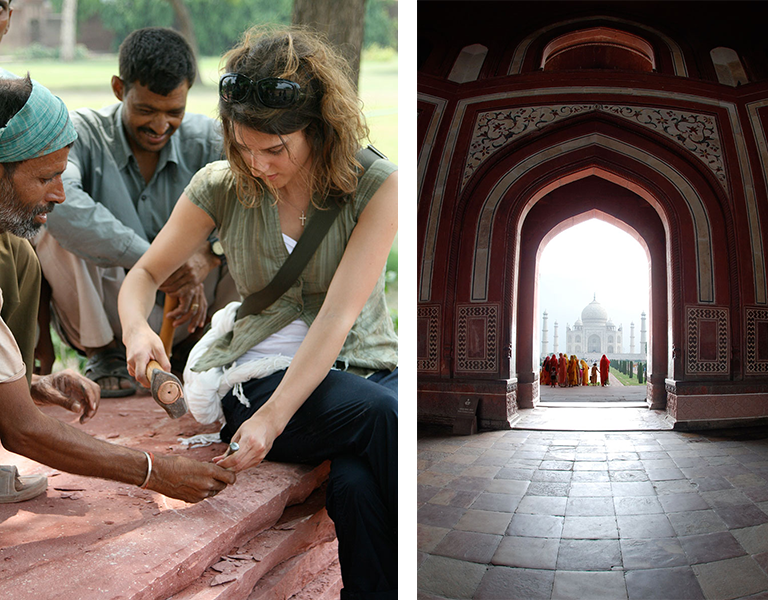|
An enquiry towards new tourism and economic growth of Agra, India |
||||
|
In partnership with the Archaeological Survey of India and UNESCO the Notre Dame team documented two of the Mughal tombs of Agra, India. The project encompassed a detailed analysis and architectural study of the tombs of:
The tombs of Itmud-ud Daulah and Akbar’s tomb are a series of progression of architectural composition, material advancement, and climatological adaptation and therefore are combined together in this study to derive a series of results that compliment the research theme and bring out the wider implication of this project. |
||||
|
Documenting the history |
||||
|
The objective of this project was to study Mughal historic monuments by interweaving ancient techniques with latest technology of 3D visualization, structural and material analysis. DHARMA team started site work for Phase II of Mughal tomb documentation in Agra, India in January 2012. In 2008, Phase I of this project involved hand and photogrammetric documentation of Akbar’s Tomb, Itmad-ud-Daulah’s Tomb, and the Taj Mahal. Phase II is extending this earlier study through the implementation of HDS laser documentation of the Akbar and Itmad-ud-Daulah tombs. 3-D digital model, and high-resolution panoramic photographs, with detailed historical and urban analysis are part of this study. Fifth-year undergraduate students as part of their concentration in Historic Preservation worked alongside professional researchers Prof. Krupali Krusche and Dr. Bhuvan Vikrama from the Archeological Survey of India to complete this study. Located on the Yamuna River near the Taj Mahal, Akbar’s Tomb is constructed out of red sandstone and white marble. The tomb has suffered loss of original full size etchings of building profiles and original symbols by craftsmen found on the pavement surrounding the monument. Documentation work is aimed at documenting the current state of the tomb interior and exterior and discovering the impact ongoing tourism is having on the site and its surrounding community. |
||||
|
Graduate student Iva Dokonal and local craftsmen at work in 2012 (left) and the south gate to the Taj Mahal (right) |
||||
|
Experiencing the culture |
||||
|
The current touristic experience of Taj is incomplete without traversing the complete complex as it was first intended. During Mughal times, the areas along the riverfront of Yamuna and the market place in front of Taj were an integrated part of the Taj complex and the site functioned as one entity. The Taj, has two major entrances. One is the royal entrance from the river front side, and the other is the traditional market entrance (with 3 gates). Both these entrances were once important and the complex was experienced through various layers of spaces that made the perception at Taj more complete. Today much of the river front entrance is lost. Partially, because the secluded underground entrance to the crypt is not open to the public and secondly because most of the Yamuna riverfront does not enjoy the quality and character it once had. The royal mughal gardens lining the Yamuna front gave a much more exhilarating experience upon approaching Taj. The recently excavated Mahtab Bagh or the moonlight garden (Bellafiore 2003), is said to be a garden that was used by Shah Jahan for the private viewing of Taj with its beautiful moonlight reflections in the reflective pool of the garden. Few if any come and see this garden, as presently the only way to access this garden is by road and one has to go half way across the town to reach it. The crowded streets and polluted air of Modern Agra make it hard to imagine the garden city as it once was. Lush, beautiful gardens lined the Yamuna River on both sides. The gardens were the early module of the city. The emperor would bequeath gardens on high-ranking nobles and reclaim the land after the noble’s death. The gardens were well maintained, and often redesigned when they passed hands. Once the Mughal capital moved to Delhi and the British began to invade, the garden system quickly disappeared. The riverfront decayed as peasants and animals took over the forgotten land. Today many of the tombs and houses are built over or destroyed. The following map is an attempt to recreate and locate the gardens and houses that once lined the Yamuna River. The majority of the information is based off of the Jaipur Map created by Rai Shivadasa for the Maharaja Sawai Jai Singh of Jaipur around 1722. The Maharaja was planning on building his own capital in Jaipur and wanted the map of Agra for comparison. Ebba Koch supplemented the Jaipur map with her own onsite research in 2000-2003. We conducted our own surveys of the river in January of 2012. |
||||


 Objectives
Objectives 
